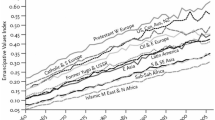Abstract
In real political life “killer amendments” are very rare. William H. Riker was the first political scientist to draw systematic attention to this special “heresthetic” phenomenon, but he was himself only able to identify a handful of successful “killer amendments”. Subsequent systematic empirical research has brought a few more to attention. In this article what may be the first successful example from outside the US context is described. It took place, when the Danish Constituent Assembly in 1849 discussed, if a proper judicial review procedure should be institutionalized in the Danish Constitution. The motion was defeated by means of what looks like a nicely orchestrated “killer amendment”.
Similar content being viewed by others
Notes
More detailed discussions of this so-called “heresthetic” strategy are scattered around in his published writings, with Riker (1986) probably being the best.
The most famous example is the so-called Powell Amendment from 1956 (Riker 1986: 114–128); but see Gilmour 2001: 249–262. See also the more general criticism in Green and Shapiro (1994: Chap. 6). Mackie (2003) has challenged all of Riker’s case studies as well as most other cycles that have been discussed in the literature.
The first time that a law of parliament was declared un-constitutional in Denmark was as late as in 1999.
Beretning om forhandlingerne paa Rigsdagen 1848–49: col. 2172), cited hereafter as BFR). In the Danish language—of that time—the clause reads: “Alle Love og Anordninger, der ere i Strid med Grundlovens Bestemmelser, ere forsaavidt uden Gyldighed”.
BFR (1848–49: col. 3372). In Danish: “Hvis denne Paragraph antages, foreslaaes det mellem Ordene “Alle” og “Love” at indskyde “hidtil udkomne” ”.
This one-dimensionality was suggested by contemporaries, e.g., Barfod (1849), as well as by all historians who have dealt with the Constituent Assembly, most notably Neergaard (1892). Nannestad Olsen (1972) did, however, by means of an analysis of 44 roll calls demonstrate that the “party” space was two-dimensional. The question of dimensionality will not be pursued here, but see Sect. 5 below.
The entire debate and the considerable number of votes and divisions taken on this and on other church-related clauses make conclusions very difficult to draw. It will definitely require much more research before we are able to categorize this sequence of events as a successful killer amendment. But that Tscherning consciously practiced a similar logic a second time is beyond doubt.
Cf. the article “Wrecking amendments—also called a poison pill amendment or killer amendment” in Wikipedia, http://en.wikipedia.org/wiki/Wreckingamendment.
Here as in the following I have to assume that the preference structures of all members are strict, an assumption that is not entirely realistic, cf. Sect. 2.
References
Bagge, P. (1947–49). Review in Historisk Tidsskrift, Vol. 11, række 2.
Barfod, P. F. (1849). In Den grundlovgivende Rigsforsamlings Historie, Copenhagen: Eget Forlag.
Beretning om Forhandlingerne paa Rigsdagen (1848–49). 2 bind. Copenhagen: Bianco Luno.
Christensen J. P. (1990). In Forfatningsretten og det levende liv. Copenhagen: Jurist- og Økonomforbundets Forlag.
Christensen, J. P. (2003). Domstolene—den tredje statsmagt. Aarhus: Magtudredningen.
Christensen, J. P. (2011). Højesteret og statsmagten. In P. Magid et al. (Eds.), Højesteret—350 år (pp. 211–309). Copenhagen: Gyldendal.
Elster, J. (1995). Strategic uses of argument. In K. Arrow et al. (Eds.), Barriers to conflict resolution (pp. 236–257). New York: Norton.
Elster, J. (1998). Deliberation and constitution making. In J. Elster (Ed.), Deliberative democracy (pp. 97–122). Cambridge: Cambridge University Press.
Finocchiaro, C. J., & Jenkins, J. A. (2008). In search of killer amendments in the modern U.S. House. Legislative Studies Quarterly, 33, 263–294.
Gilmour, J. B. (2001). The Powell amendment voting cycle: an obituary. Legislative Studies Quarterly, 26, 249–262.
Green, D. P., & Shapiro, I. (1994). Pathologies of rational choice theory. New Haven: Yale University Press.
Jenkins, J. A., & Munger, M. C. (2003). Investigating the incidence of killer amendments in congress. The Journal of Politics, 65, 498–517.
Mackie, G. (2003). Democracy defended. Cambridge: Cambridge University Press.
Matthews, D. R., & Stimson, J. A. (1975). Yeas and nays: normal decision-making in the U.S. House of Representatives. New York: Wiley-Interscience.
Matthews, D. R., & Stimson, J. A. (1977). Cue-taking by congressmen: a model and a computer simulation. In W. O. Aydelotte (Ed.), The history of parliamentary behavior (pp. 247–273). Princeton: Princeton University Press.
Møller, P. (1943–1948). Baron C. Zeuthens Dagbog fra den grundlovgivende Rigsforsamlings Tid. Danske Magazin, 7(IV), 130–228.
Nannestad Olsen, P. (1972). At the cradle of a party system: voting patterns and voting groups in the Danish Constitutional Convention 1848–1849. Scandinavian Political Studies, 7, 119–135.
Neergaard, N. (1892). Under Junigrundloven (Vol. 1). Copenhagen.
Ørsted, A. S. (1849). Prøvelse af de Rigsforsamlingen forelagte Udkast til en Grundlov og en Valglov. Copenhagen: Deichmanns Forlag.
Rasch, B. E. (1987). Manipulation and strategic voting in the Norwegian parliament. Public Choice, 52, 57–73.
Rasch, B. E. (2002). Parliamentary floor voting procedures and agenda setting in Europe. In G. Loewenberg et al. (Eds.), Legislatures—comparative perspectives on representative assemblies (pp. 269–287). Ann Arbor: University of Michigan Press.
Riker, W. H. (1965). Arrow’s theorem and some examples of the paradox of voting. In J. M. Claunch (Ed.), Mathematical applications in political science (pp. 41–60). Dallas: Arnold Foundation.
Riker, W. H. (1986). The art of political manipulation. New Haven: Yale University Press.
Sartori, G. (1987). The theory of democracy revisited. Chatham: Chatham House Publishers.
Shepsle, K. A., & Bonchek, M. S. (1997). Analyzing politics—rationality behavior, and institutions. New York: Norton.
Tscherning, A. F. (1878). Af Anthon Frederik Tschernings efterladte Papirer. Udgivet af hans efterlevende Familie. Copenhagen: P. G. Philipsens Forlag.
Wilkerson, J. D. (1999). Killer amendments in Congress. American Political Science Review, 93, 535–552.
Author information
Authors and Affiliations
Corresponding author
Additional information
Paper submitted for Special Issue on Empirical Social Choice.
Rights and permissions
About this article
Cite this article
Pedersen, M.N. A Danish killer amendment—when judicial review was banned from the 1849 Constitution. Public Choice 158, 513–523 (2014). https://doi.org/10.1007/s11127-012-0044-8
Received:
Accepted:
Published:
Issue Date:
DOI: https://doi.org/10.1007/s11127-012-0044-8



